The only issue I found with the accepted answer was that we are allocating the UITextView each and every time. I found that this raised issues with typing into the view and having the text updating immediately and also keeping the view as first responder. When I tried to reload the cell with the new height it would then try to add a new textView.
Because of this I found a slightly different method to achieve the same goal. Hopefully this different take might help people who are struggling to implement the above code.
1) In the header file define a variable for the height of the text and the textView:
UITextView * _textView;
NSInteger _textHeight;
Setting a variable means that we can load the view to be a certain height if we are loading text into the textView and also reduces the complexity.
2) Load the text view and add it to our cell
_textView = [[UITextView alloc] init];
_textView.delegate = self;
_textView.returnKeyType = UIReturnKeyDone;
_textView.font = [UIFont fontWithName:@"Helvetica" size:16];
if (![_user metaStringForKey:bBioKey].length) {
_textView.text = @"Placeholder text";
_textView.textColor = [UIColor lightGrayColor];
}
- (UITableViewCell *)tableView:(UITableView *)tableView_ cellForRowAtIndexPath:(NSIndexPath *)indexPath {
if (indexPath == 0) { // Add logic to choose the correct cell
if (_textView.superview != cell) {
[cell addSubview:_textView];
_textView.keepTopInset.equal = KeepRequired(7);
_textView.keepBottomInset.equal = KeepRequired(7);
_textView.keepRightInset.equal = KeepRequired(10);
_textView.keepLeftInset.equal = KeepRequired(70);
}
}
}
}
Using keeplayout has enabled us to keep our textfield to always stay the same height as the cell. We are also only ever adding our UITextView once.
3) Add the code to calculate the height of the text
- (NSInteger)getHeightOfBio: (NSString *)text {
UILabel * gettingSizeLabel = [[UILabel alloc] init];
gettingSizeLabel.font = [UIFont fontWithName:@"Helvetica" size:16];
gettingSizeLabel.text = text;
gettingSizeLabel.numberOfLines = 0;
CGSize maximumLabelSize = CGSizeMake(240, 9999); // this width will be as per your requirement
CGSize expectedSize = [gettingSizeLabel sizeThatFits:maximumLabelSize];
return expectedSize.height;
}
I have tried many and found this to work the best
4) Add some logic in the cell height to make use of this:
- (CGFloat)tableView:(UITableView *)tableView heightForRowAtIndexPath:(NSIndexPath *)indexPath {
if (indexPath.row == 0) { // Set the height for our changing textView
return 30 + [self getHeightOfBio:_textView.text];
}
return 44;
}
Obvious we need a bit more height than our text height so I added an extra cushion amount which can be experimented with.
5) Refresh the view each time a character is typed to check if we need to increase the size:
- (void)textViewDidChange:(UITextView *)textView {
if ([self getHeightOfText:textView.text] != _textHeight) {
_textHeight = [self getHeightOfText:textView.text];
[self.tableView beginUpdates];
[self.tableView endUpdates];
}
}
In this section we get the height of the text each time the user types.
Then though we use our stored value and compare the current value to the stored value. Obviously if they are the same then there is no point in refreshing the view. If they are different we update the value and then refresh our table.
This bit I found a good answer on stackOverflow showing how we can refresh only the heights of the table instead of the cell itself. Why refresh the cell when we don't need to? This means that once this is called the cell height is updated and it increases nicely.
Anyway I found this worked really nicely and was simple enough that it can be put together or have different parts taken and put into other peoples pieces of code.
Props to the accepted answer which was pillaged for various pieces along the way but I also hope that this answer helps some people who are having the same difficulties that I had.
